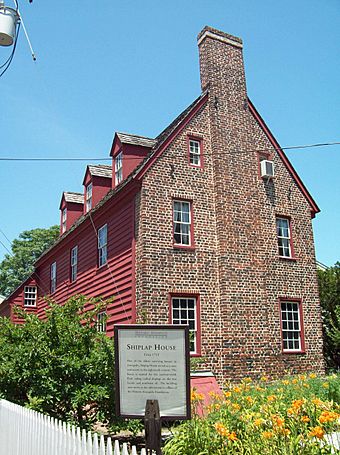Colonial Annapolis Historic District facts for kids
|
Colonial Annapolis Historic District
|
|

Shiplap House, Colonial Annapolis Historic District, July 2009
|
|
| Location | District boundaries approximate city boundaries surveyed in 1695, (original) Roughly bounded by Spa Creek, Southgate Ave., Hanover and West Sts.,(increase) Annapolis, Maryland |
|---|---|
| Built | 1695 |
| Architect | Multiple |
| Architectural style | Late Victorian, Colonial, Georgian (original) Early Republic, Late Victorian, Colonial (increase) |
| NRHP reference No. | 66000383 (original) 84003875 (increase) |
Quick facts for kids Significant dates |
|
| Added to NRHP | October 15, 1966 |
| Boundary increase | September 29, 1984 |
| Designated NHLD | June 23, 1965 |
The Colonial Annapolis Historic District is a very special area in Annapolis, Maryland. Annapolis is the capital city of Maryland. This district is like a living museum! It was named a National Historic Landmark in 1965. Later, in 1984, the district was made even larger to include more historic places.
Contents
Discovering Annapolis's Past
Annapolis has a rich history. It served as the capital for both the Maryland Colony and the State of Maryland. It was also the main town for Anne Arundel County. Annapolis is one of the first cities in colonial America that was carefully planned out.
The Original City Plan
The city's original plan was created in 1695 by Francis Nicholson. Many parts of this old plan are still visible today. About 120 buildings from the 1700s are still standing. This makes Annapolis a unique place to visit.
A Glimpse into the 1700s
Annapolis, along with Williamsburg in Virginia, shows us what life was like long ago. These two cities are like "living microcosms" of the 1700s and early 1800s. This means they are small examples that perfectly show a larger historical period.
Famous Historic Buildings
The historic district includes many important buildings. The Maryland State House is on State Circle. St. Ann's Church is nearby on Church Circle. You can also find grand homes of important people. These include the Hammond–Harwood House and the Paca House and Gardens. The larger district also has the Artisan's House, Brice House, John Callahan House, and the Chase–Lloyd House. Most of the downtown and waterfront areas were declared a National Historic Landmark in 1965.
Learning in a Historic Setting
Annapolis is home to famous schools. St. John's College was founded in 1696. Its buildings show beautiful Colonial and Federal styles. One building, McDowell Hall, was once the colonial Governor's Mansion.
The United States Naval Academy was started in 1845. It is one of the oldest military colleges in the country. Its campus has a unique French-style architecture. It sits on the site of old Fort Severn, which was used during the War of 1812.
These schools add to the city's special feel. You can see college students and naval midshipmen walking among the old brick homes.
Protecting History
Groups like the Historic Annapolis Foundation work hard to protect the city's past. They have rules for new buildings to make sure they fit in. This helps keep Annapolis's unique look from the Colonial and Federal eras safe for the future.
Exploring the Waterfront
The Colonial Annapolis Maritime Trail System is also part of the East Coast Greenway. This trail lets you explore the city's connection to the water.
Images for kids




